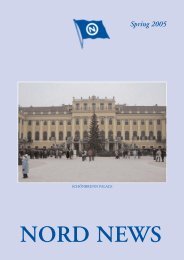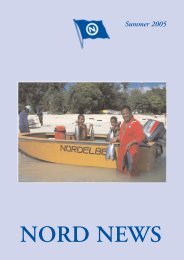WINTER 2007.qxd
WINTER 2007.qxd
WINTER 2007.qxd
Create successful ePaper yourself
Turn your PDF publications into a flip-book with our unique Google optimized e-Paper software.
10 NORD NEWS Winter 2007<br />
It’s Chris<br />
T<br />
ime seems to fly unbelievably fast and we can<br />
not escape the fact that Christmas is almost<br />
here. The joy of the season is all around us; from<br />
the decorated houses and shop windows, to the<br />
Christmas carols filling the air. Once again, we thought it<br />
would be a good idea to dedicate a small corner of our<br />
magazine to this glorious season by taking a small trip<br />
around the world (with our imagination of course) so that<br />
we can have a look at what the rest of the countries in the<br />
world are up to.<br />
“Kala Christouyenna”! from Cyprus and<br />
Greece. Many decades ago, the decoration of Christmas<br />
trees was unheard of in Cyprus and Greece. Nowadays,<br />
Christmas trees are an integral part of our decorating<br />
and Athens boasts one of the world's largest outdoor<br />
Christmas trees. On Christmas Eve children gather<br />
and visit our houses, singing "Kalanda" (carols, going<br />
back to Byzantine times) accompanied by metal<br />
triangles and are offered sweets, as a reward.<br />
A fasting period of forty days precedes<br />
Christmas (widely followed even nowadays) where we<br />
have to eat only fruit and vegetable based dishes.<br />
Therefore, on Christmas day a large feast is prepared which nowadays includes even turkey. On New year's<br />
eve, a cake called "Vasilopitta" (Santa's cake) as well as wine, are laid out for "Ayios Vasilis" (Santa Claus)<br />
who brings presents for the children under the Christmas tree and has a piece of the cake and some wine.<br />
When "Vasilopitta" (Santa's cake) is baked a coin is placed in it. Vasilopitta is cut on New Year's Day and<br />
the person who finds the coin in their piece is the luckiest person of the family for the coming year.<br />
During the twelve days (from Christmas Eve to Epiphany day on January 6) goblins called<br />
"Kallikantzari" visit the earth. They are gnome-like creatures who normally live in the center of the earth<br />
and they make their way into our homes via the chimneys, creating all sorts of mischief. To keep them<br />
appease, we make special sweets which we throw on the roofs of the houses, for them to eat. All year they<br />
work hard with their axes, trying to cut the tree that holds the earth in its branches and only stop for a break<br />
during Christmas. Of course these twelve days are enough for the tree to mend. On January 6, Epiphany<br />
day, (which symbolizes the spiritual rebirth of man since Christ was baptized in the river Jordan) a mass takes<br />
place in churches in order to bless the waters and chase away the bad spirits, thus our "Kallikantzari" are<br />
once again banished to the centre of the earth.<br />
On Epiphany day a ceremonial baptism is performed at all seaside towns whereby the holy cross is<br />
thrown into the sea and all young men dive in the cold water, trying to retrieve the cross. The person who<br />
retrieves the cross is the lucky one again for the year.<br />
"Buon Natale" from the neighboring Italy. Christmas in Italy is a mixture of Christianity, blended<br />
with a pagan tradition dating back to the Roman Empire "Saturnalia" (a winter solstice celebration).<br />
"Saturnalia" was a public festival that took place on December 17, in ancient Rome. The roles of slaves and<br />
masters were reversed only for that day and slaves were exempted from punishment. The celebrations also<br />
included the making and giving of small presents, eating, drinking and everyone being merry.<br />
In more recent years, the festivities are ushered in by the "Piferari" or fifers, as they descend from the<br />
mountains of the Abruzzo, playing traditional tunes on their bagpipes, in joyous anticipation of the<br />
celebrations to come. Beautiful Cribs (manger scenes) are the main decorations for the season and there are<br />
often contests between churches for the most beautiful Crib. The figurines are made of clay or plaster,<br />
picturing the infant Jesus, Mary and Joseph, as well as the animals keeping the child warm with their breath.<br />
The familiar scene of the birth of Jesus is intricately decorated with lights, small trees and Angels.
















